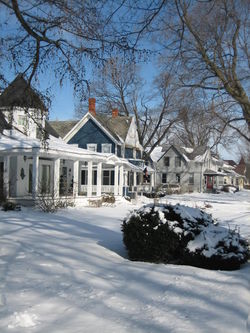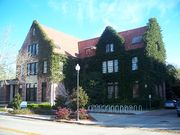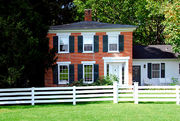Historic district (United States)

A historic district in the United States is a group of buildings, properties or sites that have been designated by one of several entities on different levels as historically or architecturally significant. Buildings, structures, objects and sites within a historic district are normally divided into two categories, contributing and non-contributing. Districts greatly vary in size: some have hundreds of structures, while others have just a few.
The U.S. federal government designates historic districts through the U.S. Department of Interior, under the auspices of the National Park Service. Federally designated historic districts are listed on the National Register of Historic Places. State Historic Districts can either follow similar criteria and have no restrictions on property owners or they can require strict adherence to historic rehabilitation standards. The local historic district offers, by far, the most legal protection for historic properties because most land use decisions are made at the local level. Local districts are generally administered by the county or municipal government. The tendency of local districts to place restrictions on property owners causes them to be the targets of the most resistance from the public.
The first historic district was located in Charleston, South Carolina and predated the first U.S. federal government designated district by more than thirty years. Other local historic districts popped up and in 1966 the U.S. government created the National Register of Historic Places on the heels of a report from the U.S. Conference of Mayors which stated Americans suffered from "rootlessness."[1] By the 1980s there were thousands of federally designated historic districts.
Contents |
Property types

Historic districts are generally two types of properties, contributing and non-contributing.[2] Broadly defined, a contributing property is any property, structure or object which adds to the historical integrity or architectural qualities that make a historic district, listed locally or federally, significant.[3] Different entities, usually governmental, at both the state and national level in the United States, have differing definitions of contributing property but they all retain the same basic characteristics.[3][4] In general, contributing properties are integral parts of the historic context and character of a historic district.[5]
In addition to the two types of classification within historic districts, properties listed on the National Register of Historic Places are classified into five broad categories. They are, building, structure, site, district and object; each one has a specific definition in relation to the National Register. All but the eponymous district category are also applied to historic districts listed on the National Register.[6]
Federal-level

A listing on the National Register of Historic Places is governmental acknowledgment of a historic district. However, the Register is "an honorary status with some federal financial incentives."[7] The National Register of Historic Places defines a historic district per U.S. federal law, last revised in 2004.[6] According to the Register definition a historic district is:
"a geographically definable area, urban or rural, possessing a significant concentration, linkage, or continuity of sites, buildings, structures, or objects united by past events or aesthetically by plan or physical development. A district may also comprise individual elements separated geographically but linked by association or history."[6]
Districts established under U.S. federal guidelines generally begin the process of designation through a nomination to the National Register of Historic Places. The National Register is the official recognition by the U.S. government of cultural resources worthy of preservation.[8] While designation through the National Register does offer a district or property some protections, it is only in cases where the threatening action involves the federal government. If the federal government is not involved, then the listing on the National Register provides the site, property or district no protections.[9] For example, if company A wants to tear down the hypothetical Smith House and company A is under contract with the state government of Illinois, then the federal designation would offer no protections. If, however, company A was under federal contract the Smith House would be protected. A federal designation is little more than recognition by the government that the resource is worthy of preservation.[9]
In general, the criteria for acceptance to the National Register are applied consistently, but there are considerations for exceptions to the criteria and historic districts have influence on some of those exceptions. Usually, the National Register does not list religious structures, moved structures, reconstructed structures, or properties that have achieved significance within the last 50 years. However, if a property falls into one of those categories and are "integral parts of districts that do meet the criteria" then an exception allowing their listing will be made.[6] Historic district listings, like all National Register nominations, can be rejected on the basis of owner disapproval. In the case of historic districts, a majority of owners must object in order to nullify a nomination to the National Register of Historic Places. If such an objection occurred, then the nomination would become a determination of National Register eligibility only.[6]
State-level

Most U.S. state governments have a listing similar to the National Register of Historic Places. State listings can have similar benefits to federal designation, such as granting qualification and tax incentives. In addition, the property can become protected under specific state laws.[9] The laws can be similar or different from the federal guidelines that govern the National Register. A state listing of a historic district on a "State Register of Historic Places," usually by the State Historic Preservation Office, can be an "honorary status," much like the National Register. For example, in Nevada, listing in the State Register places no limits on property owners.[10] In contrast, state law in Tennessee requires that property owners within historic districts follow a strict set of guidelines, from the U.S. Department of Interior, when altering their properties.[11] Though, according to the National Historic Preservation Act of 1966, all states must have a State Historic Preservation Office, not all states must have a "state historic district" designation. As of 2004, for example, the state of North Carolina had no such designation.[12]
Local-level
_by_David_Shankbone.jpg)
Local historic districts usually enjoy the greatest level of protection, under law, from any threats that may compromise their historic integrity. This is because many land-use decisions are made at the local level.[9] There are more than 2,300 local historic districts in the United States.[13] Local historic districts can be administered at the county or the municipal level; both entities are involved in land use decisions.[14]
According to the National Park Service, historic districts are one of the oldest forms of protection for historic properties. The city of Charleston, South Carolina is credited with beginning the modern day historic districts movement.[15] In 1931 Charleston enacted an ordinance which designated an "Old and Historic District" which was administered by a Board of Architectural Review.[15] Charleston's early ordinance reflected the strong protection that local historic districts often enjoy under local law. It asserted that no alteration could be made to any architectural features which could be viewed by the public from the street.[15] Other local historic districts, such as that in Savannah, Georgia, predate the Register by 10 years or more as well.[16]
Local historic districts are most likely to generate resistance because of the restrictions they tend to place on property owners.[17][18][19] Local laws can cause residents to "manage … obligations to comply with (local historic district) ordinances."[20] Examples of local preservation laws can be found in Nashville, Tennessee, where the city has adopted the stricter of two sets of criteria.[11] In Nashville, per state and local law, building design criteria for structures that are designated as parts of local "preservation districts" are derived from the U.S. Secretary of Interior's Standards for the Rehabilitation of Historic Buildings. For property owners within these preservation districts to make alterations they must adhere to a set of guidelines which concern roof form and materials, front and side porches (no screens allowed), shape, style and placement of windows and doors, construction materials (no hardboard, masonite, aluminum, or vinyl cladding allowed), lighting fixtures, fences, paving, and paint color (for masonry structures).[11]
Resistance to historic district designations and expansions is fairly widespread. In New York City, in 2006, residents resisted the designation of historic district for Fieldston, a Bronx neighborhood, because of the increase in regulations and decrease in property values associated with historic districts.[17] Historic district advocates claim that the designation does not harm property values, and they claim studies prove they increase property values. Yet, actual real estate investors generally disagree. The studies that show property value increases are flawed by not accounting for value trends prior to historic district designation. Historic district designations are usually introduced after economic pressures raise property values and provide investors with incentives for demolition. In April 2007 residents and politicians in Rochester, New Hampshire resisted a historic district boundary increase. The local newspaper called the increase "overreaching" and noted regulations on paint color and interior renovations as reasons for its opposition to the proposal.[19]
Significance
The original concept of an American historic district was as a protective area surrounding more important, individual historic sites. As the field of historic preservation progressed, those involved came to realize that the structures acting as "buffer zones" were actually key elements of the historic integrity of larger, landmark sites. Preservationists came to the view that districts should be more encompassing, blending together a mesh of structures, streets, open space and landscaping to define the historical character of a historic district.[23]
As early as 1981 the National Trust for Historic Preservation identified 882 American cities and towns that had some form of "historic district zoning" in place; local laws meant specifically to protect historic districts. Before 1966, historic preservation in the United States was in its infancy. That year the U.S. Conference of Mayors penned an influential report which concluded, in part, that Americans suffered from a sense of "rootlessness."[1] They recommended historic preservation to help provide Americans with a sense of orientation. The creation of the National Register of Historic Places in 1966, on the heels of the report, helped to instill that sense of orientation the mayors were looking for.[1] The mayors also recommended that any historic preservation program not focus solely on individual properties but also on "areas and districts which contain special meaning for the community." Local, state and federal historic districts now account for thousands of historic property listings at all levels of government.[1]
See also

- Adaptive reuse
- Conservation area
- Historic preservation
- Zoning
References
- ↑ 1.0 1.1 1.2 1.3 Datel, Robin Elisabeth. "Preservation and a Sense of Orientation for American Cities," Geographical Review, Vol. 75, No. 2. (Apr., 1985), pp. 125-141. Retrieved April 4, 2007.
- ↑ National Register Historic Districts Q&A, South Carolina Department of Archives and History. Retrieved February 19, 2007.
- ↑ 3.0 3.1 Historic and Scenic Preservation Local Option Property Tax Reimbursement, Maine Historic Preservation Commission. Retrieved February 19, 2007.
- ↑ Ordinance No. 2001-02, (PDF), Daville, California ordinance, California Office of Historic Preservation. Retrieved February 19, 2007.
- ↑ Iowa City Historic Preservation Handbook, (PDF), Iowa City Urban Planning Division. Retrieved March 26, 2007.
- ↑ 6.0 6.1 6.2 6.3 6.4 Title 36: Section 60.3, Parks Forests and Public Property, Chapter One, Part 60. National Register of Historic Places. Retrieved February 19, 2007.
- ↑ Strengths of Local Listing, Working on the Past in Local Historic Districts, National Park Service. Retrieved February 20, 2007.
- ↑ "About the Register," National Register of Historic Places, National Park Service. Retrieved April 4, 2007.
- ↑ 9.0 9.1 9.2 9.3 Federal, State and Local Historic Districts, Toolbox, FAQ, National Park Service. Retrieved February 19, 2007.
- ↑ Whaley, Sean. "State adds Goldfield to historic places registry," Las Vegas Review-Journal, December 24, 2005. Retrieved April 4, 2007.
- ↑ 11.0 11.1 11.2 Kreyling, Christine. "Something Old, Something New," Planning; August/September 2006, Vol. 72 Issue 8, p34-39, 6p. Retrieved April 4, 2007.
- ↑ Nicholson, Scott. "Commissioners Address Alcohol Sales In Valle Crucis," The Mountain Times, August 5, 2004. Retrieved April 4, 2007.
- ↑ Bringing Preservation Home, Working on the Past in Local Historic Districts, National Park Service. Retrieved February 19, 2007.
- ↑ "Local laws as neighborhood guardians," Working on the Past in Local Historic Districts (Section B), National Park Service. Retrieved October 5, 2009.
- ↑ 15.0 15.1 15.2 Early Models, Working on the Past in Local Historic Districts, National Park Service. Retrieved February 20, 2007.
- ↑ Brown, Kay. " Old Savannah," Chicago Defender, November 17, 1973, p.22, col.3. Retrieved April 4, 2007.
- ↑ 17.0 17.1 Hu, Winnie. "Council Poised to Intervene on Enclave's Landmark Status," New York Times; March 25, 2006, Vol. 155 Issue 53529, pB1-B5, 2p, 1bw. Retrieved April 4, 2007.
- ↑ Vandam, Jeff. "Brick Houses, Winding Paths and Unexpected Sharp Elbow," New York Times; December 31, 2006, Vol. 156 Issue 53810, Section 14 p5-5, 1/3p. Retrieved April 4, 2007.
- ↑ 19.0 19.1 "Rochester Historic District expansion plan overreaches," (Editorial), Foster's Daily Democrat, April 3, 2007. Retrieved April 4, 2007.
- ↑ Heuer, Ted. "Living History: How Homeowners in a New Local Historic District Negotiate Their Legal Obligations," Yale Law Journal; January 2007, Vol. 116 Issue 4, p768-822, 55p. Retrieved April 4, 2007.
- ↑ "Davis-Jefferson Historic District," Bloomington Historic Preservation Commission, City of Bloomington. Retrieved April 4, 2007.
- ↑ NRIS Database, National Register of Historic Places, National Park Service. Retrieved April 4, 2007.
- ↑ Bigolin, Steve. The Sycamore Historic District: Introduction, Daily Chronicle, August 14, 2006. Retrieved February 20, 2007.
|
||||||||||